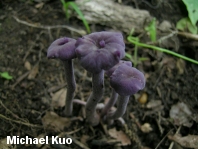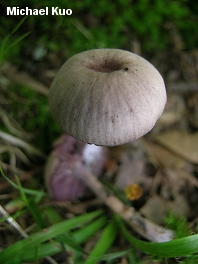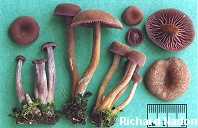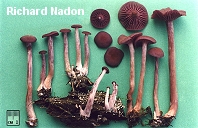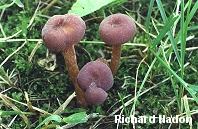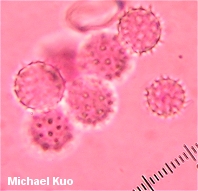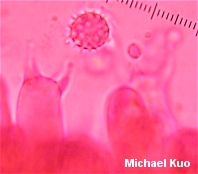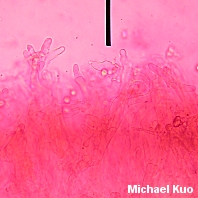| Major Groups > Gilled Mushrooms > Pale-Spored > Laccaria > Laccaria amethystina |

|
Laccaria amethystina [ Basidiomycetes > Agaricales > Hydnangiaceae > Laccaria . . . ] by Michael Kuo This little mushroom is easily recognized: it has thick purple gills, a white spore print, and a small cap that is initially purple but soon fades to buff or brownish. It is found east of the Rocky Mountains, under hardwoods. For a similar mushroom found west of the Rockies, see Laccaria amethysteo-occidentalis. Laccaria amethystina looks a little like a small Cortinarius in the subgenus Seriocybe, but those mushrooms have a cortina covering the young gills, and rusty brown spore prints (consequently, the gills in mature specimens are also rusty brown). Laccaria amethystea is a synonym. The name Laccaria amethystina was previously misapplied, on the West Coast, to Laccaria amethysteo-occidentalis, but that species has broadly elliptical, rather than round, spores, as well as a shaggier stem. Description: Ecology: Mycorrhizal with hardwoods (especially partial to oaks and beech); growing alone, scattered, or gregariously; late spring and summer; widely disributed east of the Rocky Mountains. Cap: 0.5-3.5 cm; broadly convex to flat; often with a central depression; the margin even or inrolled, not lined, or slightly lined at maturity; finely hairy-scaly, or nearly bald; bright grayish purple, fading to buff; changing color markedly as it dries out (often resulting in "two-toned" specimens). Gills: Attached to the stem, or rarely running down it; distant or nearly so; thick; waxy; dark purple or colored like the cap. Stem: 1-7 cm long; 1-7 mm thick; equal or slightly swollen at the base; finely to coarsely hairy or scaly; colored like the cap; with lilac to whitish basal mycelium. Flesh: Insubstantial; colored like the cap or paler. Odor and Taste: Not distinctive. Chemical Reactions: KOH on cap surface brownish. Spore Print: White. Microscopic Features: Spores 7-10 µ; globose; ornamented with spines 1.5-3 µ long and over 1 µ wide at their bases; inamyloid. Basidia 4-spored, rarely 2-spored. Cheilocystidia narrowly cylindric, subclavate, or somewhat irregular; 25-65+ x 4-12 µ. Pileipellis a cutis of elements 6-20 µ wide, with upright individual elements or bundles of upright elements; terminal cells subclavate to capitate. REFERENCES: (Hudson, 1778) Cooke, 1884. (Smith, Smith & Weber, 1979; Phillips, 1991/2005; Metzler & Metzler, 1992; Bessette, Miller, Bessette & Miller, 1995; Mueller, 1997; Barron, 1999; Halling & Mueller, 2005; McNeil, 2006; Bionion et al., 2008.) Herb. Kuo 06129605, 08270207, 05120704, 05281005. This site contains no information about the edibility or toxicity of mushrooms. |
© MushroomExpert.Com |
|
Cite this page as: Kuo, M. (2010, December). Laccaria amethystina. Retrieved from the MushroomExpert.Com Web site: http://www.mushroomexpert.com/laccaria_amethystina.html |
